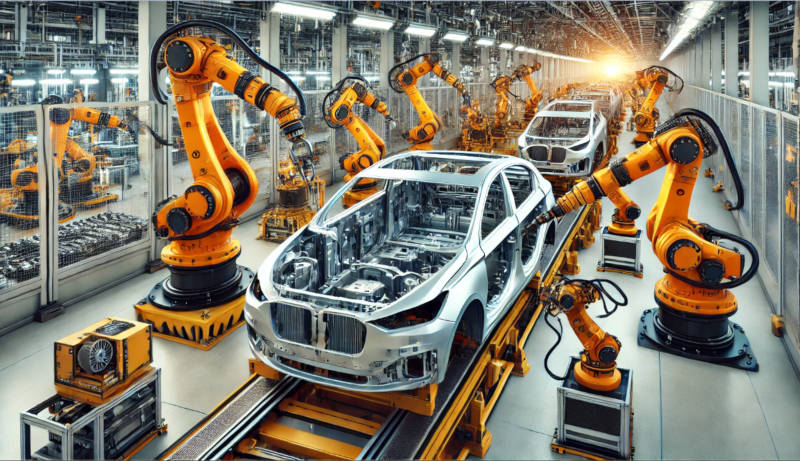Tesla’s global network of factories, known as Gigafactories, is at the forefront of automotive and energy product manufacturing. These factories employ a range of advanced machinery and technologies to produce electric vehicles (EVs), energy storage systems, and solar products. This article explores the key types of machinery used in Tesla factories and provides an overview of the main Tesla production facilities worldwide.
Key Machinery and Technologies in Tesla Factories
Robotic Arms and Automation Systems
Automation is central to Tesla’s manufacturing process, and the company leverages cutting-edge robotic systems to enhance efficiency and precision.
- KUKA Robots: These robots are integral to the assembly of car bodies, battery installation, and other critical tasks. KUKA robots are renowned for their reliability and flexibility, making them ideal for various manufacturing processes.
- FANUC Robots: Used for precise welding, painting, and assembly tasks, FANUC robots help ensure that Tesla’s vehicles meet stringent quality standards. Their high precision and speed contribute significantly to the overall efficiency of the production line.
Gigapresses
A standout feature in Tesla’s manufacturing arsenal is the Gigapress, a massive die-casting machine.
- IDRA Gigapress: This machine is capable of producing large single-piece castings for vehicle bodies, which reduces the number of parts and assembly time. By simplifying the body structure, the Gigapress enhances the durability and safety of Tesla vehicles while streamlining the manufacturing process.
Battery Production Equipment
Tesla’s advancements in battery technology are critical to its success, and the company employs state-of-the-art equipment for battery production.
- Battery Cell Production Lines: These lines include machinery for electrode manufacturing, cell assembly, and formation. Each step is optimized for efficiency and quality, ensuring that Tesla’s batteries are among the best in the industry.
- Dry Battery Electrode Technology: This innovative technology reduces the need for wet chemical processes in battery manufacturing, making the process more environmentally friendly and cost-effective.
Conveyor Systems
Automated conveyor systems play a vital role in transporting parts and assemblies throughout Tesla’s production lines, ensuring smooth and efficient movement of materials.
Paint Shops
Tesla’s paint shops are equipped with advanced robotic systems to apply multi-layer coatings with high precision.
- Advanced Paint Robots: These robots ensure that each vehicle receives a high-quality finish with minimal waste, enhancing both the aesthetic appeal and durability of Tesla’s cars.
Quality Control and Inspection Systems
Ensuring the highest quality standards is a priority for Tesla, and the company uses advanced inspection systems to achieve this.
- 3D Laser Scanning and X-ray Inspection Systems: These technologies are used for quality assurance of parts and assemblies, helping to identify and address any defects early in the production process.
Press Shops
Tesla’s press shops use both hydraulic and mechanical presses to stamp metal sheets into body panels and other components, creating the structural elements of its vehicles.
Assembly Lines
The final assembly of Tesla vehicles integrates mechanical, electrical, and software components.
- Automated and Semi-Automated Lines: These lines combine human oversight with robotic precision, ensuring that each vehicle is assembled to the highest standards.

Main Tesla Factories Worldwide
Tesla’s factories are strategically located around the globe to serve major markets efficiently. Here is an overview of the key production facilities:
Tesla Fremont Factory (Fremont, California, USA)
- Products: Model S, Model 3, Model X, and Model Y.
- Significance: As Tesla’s first factory, it remains a significant hub for manufacturing and innovation. The Fremont factory showcases Tesla’s commitment to integrating advanced manufacturing technologies.
Gigafactory Nevada (Sparks, Nevada, USA)
- Focus: Battery cell production, energy storage products (Powerwall, Powerpack, and Megapack), and electric motors.
- Significance: This factory is crucial for Tesla’s battery production and energy products, supporting the company’s goal of sustainable energy solutions.
Gigafactory New York (Buffalo, New York, USA)
- Specialization: Solar products, including Solar Roof and solar panels, as well as Supercharger components.
- Significance: Gigafactory New York plays a vital role in Tesla’s energy product lineup, emphasizing the company’s dedication to renewable energy.
Gigafactory Shanghai (Shanghai, China)
- Products: Model 3 and Model Y for the Chinese market and export.
- Significance: As Tesla’s first factory outside the USA, it serves as a key production hub in Asia, catering to the growing demand for EVs in the region.
Gigafactory Berlin-Brandenburg (Grünheide, Germany)
- Focus: Producing Model Y for the European market, with plans to include battery cell production and other advanced manufacturing technologies.
- Significance: This factory underscores Tesla’s commitment to the European market, aiming to reduce production and transportation costs while meeting regional demand.
Gigafactory Texas (Austin, Texas, USA)
- Products: Model Y and the upcoming Cybertruck.
- Significance: Expected to become a major production hub, this factory will feature advanced manufacturing capabilities, further solidifying Tesla’s presence in the U.S. automotive industry.
Tesla’s global network of factories utilizes a range of advanced machinery and technologies to produce high-quality electric vehicles, energy storage systems, and solar products. From robotic arms and Gigapresses to battery production equipment and automated assembly lines, these facilities are at the forefront of manufacturing innovation. Strategically located to serve major markets, Tesla’s factories are pivotal in enabling the company to scale its operations and meet global demand, reinforcing its position as a leader in the sustainable energy and automotive sectors.



